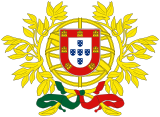1822 Portuguese legislative election
 |
|---|
| Constitution |
Parliamentary elections were held in Portugal on 22 November 1822.[1] The elections were the only vote held under the 1822 constitution, which provided for a unicameral legislature.[2]
Background
The Liberal Revolution of 1820 would lead to the 1820 Portuguese elections and to the Constituent Cortes of 1820.[3] The Constituent Cortes would approve the Portuguese Constitution of 1822,[3] along with alterations to the electoral system that would be implemented in 1822.[4]
Electoral system
Unlike in 1820, when an indirect system was used, members of the new 118-seat legislature were elected directly by secret vote according to the electoral law passed on 11 July 1822;[1][2] 111 were elected from multi-member constituencies (102 on the mainland and 9 on islands) with between three and six seats, with an additional seven single-member constituencies representing overseas colonies.[1][5]
A two-round system was used, with candidates needing to receive at least 50% of the vote in the first round to be elected; in the second round only a plurality was required.[5]
All men over the age of 25 were enfranchised except members of religious orders, servants, vagabonds and those still dependent on their parents.[2] Men who were married, serving in the military, had graduated from university or were part of the secular clergy were allowed to vote if they were aged 20 or over.[2] In comparison with the previous election of 1820, this election would also restrict voting rights to the literate.[6]
| Province | Electoral districts[4] | Number of deputies[4] |
|---|---|---|
| Minho | Arcos de Valdevez, Barcelos, Braga, Guimarães, Penafiel, Porto | 25 |
| Trás-os-Montes | Bragança, Vila Real | 9 |
| Beira | Arganil, Aveiro, Castelo Branco, Coimbra, Feira, Guarda, Lamego, Trancoso, Viseu | 32 |
| Estremadura | Alenquer, Leiria, Lisboa, Setúbal, Tomar | 23 |
| Alentejo | Beja, Évora, Portalegre | 9 |
| Algarve | Faro | 4 |
| Outside of mainland Portugal | ||
| Adjacent Islands | Madeira (3) and Açores (3) | 6 |
| Brasil | Alagoas, Bahia, Ceará, Espírito Santo, Goiás, Maranhão, Pará, Paraíba, Pernambuco, Piauí, Rio de Janeiro, Rio Negro, Santa Catarina, São Paulo | 39 |
| Colonies | Angola (1), Cabo Verde (2), São Tomé e Príncipe (1), Moçambique (1), Goa (1), Macau, Timor e Solor (1) | 7 |
Aftermath

The Vilafrancada (27 May 1823) would mark the beginning of the end of the 1822 constitution and a return to absolutism.[4] The parliament held its last session on 2 June 1823, when it approved a declaration against any change to the 1822 constitution.[7] Two days later, John VI of Portugal signs a letter declaring that the constitution needs reform and later summons the Portuguese Cortes. The Septembrism movement would reinstate the 1822 constitution (12 September 1836 - 4 April 1838).[7]
References
- ^ a b c 1822 November 22 Archived 2016-09-16 at the Wayback Machine ISCSP
- ^ a b c d Dieter Nohlen & Philip Stöver (2010) Elections in Europe: A data handbook, p1529 ISBN 978-3-8329-5609-7
- ^ a b "Monarquia". www.parlamento.pt. Retrieved 2020-07-18.
- ^ a b c d Costa, Joana Filipa Pereira (2019-05-14). "O processo eleitoral de 1822 na província de Entre-Douro-e-Minho". Revista de História das Ideias (in Portuguese). 37: 79–108. doi:10.14195/2183-8925_37_4. ISSN 2183-8925.
- ^ a b Nohlen & Stöver, p1530
- ^ Ramos, Rui (2004). "Para uma história política da cidadania em Portugal". Análise Social (172): 547–569. ISSN 0003-2573.
- ^ a b "Monarquia". www.parlamento.pt. Retrieved 2020-07-20.